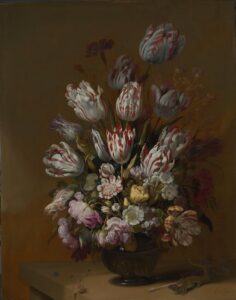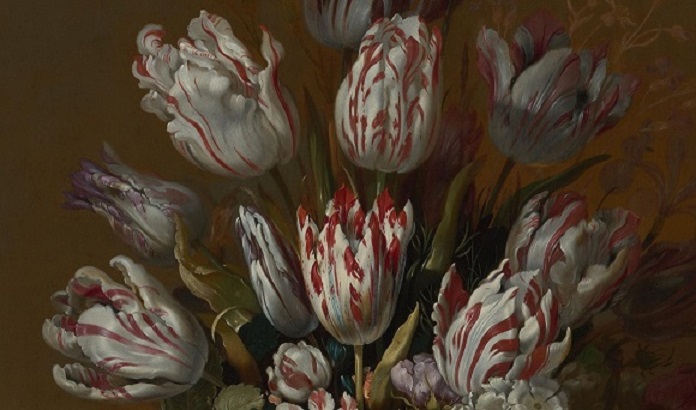As International Women's day is approaching, and the flowers of Spring are just around the corner, it’s only fitting that we take a look at a fascinating period of Dutch history and a floral mystery that perplexed the world of botany for hundreds of years, only to be finally solved by a little-known female scientist.
The Desire for Beauty
You may have heard the story of the so-called “Tulip mania” (Dutch: tulpenmanie) that gripped 17th century Holland like a vice. Stories of tulips costing more than a king’s ransom, farmers throwing themselves into canals over lost profits, or even resorting to murder and theft of bulbs are fairly well-known. These stories, whilst amusing, are greatly exaggerated and often rather far-fetched.
That’s not to say that tulip mania never occurred, however. Certain varieties of tulip did command great prices, sometimes hundreds or even thousands of guilders. The most valuable and beautiful varieties were the so-called Broken Tulips. These flowers had petals with two different variegating colours entwining across the petals in a beautiful display of flame-like patterns. The condition of colour ‘breaking’ in a tulip was first identified by Carolus Clusius, a founding father of botany and horticulture, in 1576. Though he could not determine the cause of this phenomenon, he noted that broken tulips were much weaker and would die quicker than regular varieties.
The King of Tulips

Tulips that exhibited breaking were highly prized and extremely valuable. None more so than Semper Augustus. Even surrounded by other broken tulips, Semper Augustus stood tall as the most alluring of all tulips. With its stark white flames in thick contrast to its red petals, it drew the eye of any who beheld it. Contemporary still-life paintings of Semper Augustus captured its beauty to share across Holland and beyond, and only increased the desire for the flower. Whilst it is hard to find reliable historical information, it was rumoured that Semper Augustus bulbs fetched over 6,000 guilders (about £360,000 in today's money).
The scarcity of broken tulips only increased their value. Tulips that exhibited breaking grew seemingly at random, and with no knowledge of what caused it, tulip farmers resorted to extreme methods in vain attempts to grow even a single flower. Some would sprinkle red ox blood and white chalk on the soil over a bulb in the hopes that the colour would soak into the tulip. Others would tie half a red bulb and half a white bulb together with string, trying to create a single combined flower. Unsurprisingly, none of these attempts were ever successful. Following the end of the tulip mania period, tulip growers were still none the wiser about what caused such beautiful variegation. This would remain a mystery for nearly 300 years.
Dorothy Cayley
By the end of the 19th century, the general consensus was that some form of adverse environmental condition was the cause of breaking, though no one was certain. These vague explanations persisted until 1928, when a woman named Dorothy Cayley entered the tulip scene. Dorothy was a mycologist who had a great interest in plant and fungal diseases and how they spread. She had previously identified the fungus responsible for fruit tree die-back and had presented her findings at the 1923 Royal Society Exhibition. She was the only woman to present during the event, which was emblematic of the large gender disparity in science at the time.

Dorothy was convinced that tulip breaking was caused by some form of pathogen rather than some nebulous environmental factor, and in 1928, she performed a series of studies to find the cause once and for all. She conducted tissue experiments with broken and regular tulip bulbs. Some normal bulbs were plugged with tissue from broken bulbs, whilst others were fully grafted to broken bulbs. The rest of the regular bulbs were injected with a liquid made from filtered broken bulb tissue. These bulbs were then allowed to mature into flowers.
Her results found that all the plugged bulb flowers showed some slight breaking, some grafted bulbs showed heavy breaking, and no breaking was present in the injected bulbs. From this, she deduced that the degree of breaking is proportional to the amount of infected tissue introduced to a normal bulb, and that the cause of the colour changes must be a virus that was spread by insects like aphids carrying infected sap between tulips. This meant that variegated tulips were not a distinct species, but instead, a single-hued tulip that the virus infects and causes to “break” the plant’s lock on its colour, resulting in a beautiful broken colour tulip. And in the 1960s, Dorothy’s deductions were proven to be completely correct, when for the first time, the Tulip Breaking Virus (TBV) was found to exist, and is now considered to be one of the earliest documented plant viruses.
Every Rose Has Its Thorn
No one could have ever imagined something so small would cause such a headache for 17th century Dutch farmers. But today, you may be wondering why you’ve never seen Semper Augustus in Valentine’s Day bouquets, or in vases on the mantelpiece. Unfortunately, as the saying goes: every rose has its thorn. The source of Semper Augustus’s beauty was also its downfall. TBV may have created beautiful coloration, but it also causes great fragility. Infected bulbs degrade rapidly, and quickly become too weak to flower, causing the genetic line to eventually die out. All we have left now are paintings showcasing its beauty.
In an attempt to create virus-free alternatives, breeders have developed similar tulips over the years, which many find to be just as beautiful as the original (such as the sorbet tulip). But others consider these to be poor imitations of the original’s splendour.
You may agree or disagree with these opinions, for in the end, beauty is in the eye of the beholder.

Further reading
If you would like to learn more, here are some useful resources:
Respond



